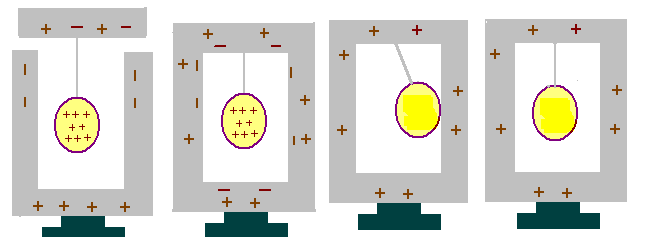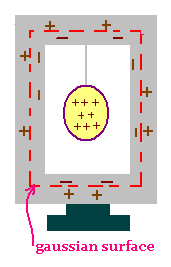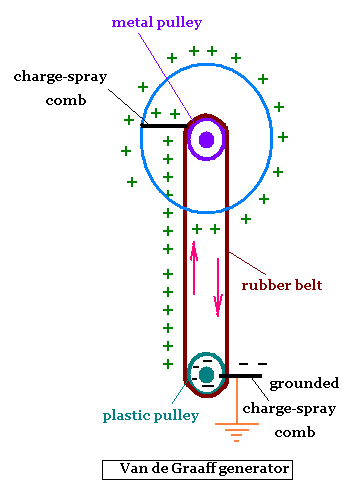|
Electrostatics
Electromagnetics
Electricity &
Magnetism
© The scientific sentence. 2010
|
Charges and devices
1. The Faraday ice-pail experiment
This experiment shows an important result is electrostatics.
Neither an electric field nor a volume charge density
exists inside a conductor under static conditions
.
Inside a charge conductor, there is no electric field,
and there is no charge. The excess of charge reside
always on the outside surface of the conductor. We use the
Faraday ice-pail experiment and Gauss's law to find this result.

The Faraday ice-pail experiment contains a charged metal
sphere lowered into a neutral metal bucket on an insulating
stand. We use an electrometer, the device that
measures charge to indicate the presence of charge outside the
bucket.
If we hang a charged metal sphere inside a closed metal can, the
bucket becomes charged as the sphere is lowered.
Once the bucket encloses completely the sphere and
tilted, the sphere touches the inside of the can. The sphere
loses its charge and the electrometer reading is unaffected; that
is the outside of the can has a charge equal to the original
charge on the sphere.

At each point along the chosen gaussian surface the electric
field E is zero. The charge enclosed is then zero. That is
the charge on the inner surface of the bucket is equal and
opposite the charge on the sphere. Since the bucket
is neutral, the charge on its outer surface is equal to
the charge of the sphere.
2. The Van de Graaff generator

The Van de Graaff generator contains an electric
motor at the base that drives a plastic pulley which drives
A rubber belt.As the plastic pulley rotates, hence it acquires
a negative charge from the rubber belt by triboelectrification
that is a rolling contact between two different materials.
Therefore, the inside surface of the rubber belt becomes
negatively charged. By induction, the outside of the belt
becomes positively charged.
A conducting brush called the charge-spray-comb, at
the base of the pulley drains the negative charges on
the outside of the belt to ground. At the top of the rubber belt, the
metal pulley is connected to a second charge-spray comb
which is connected to the collector which is the
outer metal sphere.
The collection of positive charge continues while
the belt is being driven. At the outer metal sphere of radius R, the
positive free charge Q is uniformly distributed, and the electrostatic
potential is Q/4πεoR.
As the generator continues to produce charge on the
sphere, the related potential difference between
the sphere and the ground can reach some million volts. While the
charge is accumulated,the air around the sphere becomes ionized.
Charging continues until a voltage break down occurs
in the air, that results in an arc between the sphere and
the ground.
We use also a ground sphere, positioned few inches away
from the Van de Graaff dome metal sphere, and grounded to the base
of the Van de Graaff. While the dome is charging, the ground sphere
becomes charged, by induction, with an opposite sign charge.
Note that we can reverse the charge of the sphere by simply
reversing the two pulleys.
When the dome becomes enough charged, the ground sphere
is attracted to the dome and a spark occurs. After the spark,
the two spheres lose their charges.
|
|